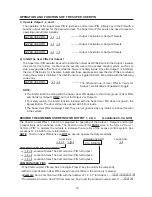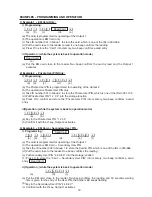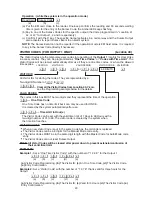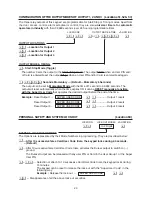
12 : OUTPUT 3 (NPN Transistor Open Collector Output)
An NPN transistor open collector output that is controlled by the Group 3 User PINs or Cards for
Output 3. It has the maximum power rating of 24VDC/100mA sink. It is equivalent to an N.O. (Normally
Open) terminal referring to ground. It can be used to drive small power device, such as a relay or a
low power control point of other equipment. This output point is programmable for Start/Stop (toggle)
mode or Momentary timing mode. See programming Location 53 for the details.
13 - 14 : TAMPER N.C. (Tamper Switch Normally Closed Contact)
A normally closed dry contact while the keypad is secured on its box. It is open while keypad is
separated from the box. Connect this N.C. terminal to the 24 hour protection zone of an alarm system
if necessary.
15 : DOOR SENS N.C. (Door Position Sensing Input -- Normally Close)
A Normally Closed (N.C.) sensing point referring to (-) ground, with the help of a normally closed
magnetic contact monitors the open or close status of the door. It initiates the following functions for
the system. Connect it with jumper to (-) Ground if not used.
a) Door Auto Re-lock
The system immediately re-locks the door after it is re-closed before the end of the programmed
time for output 1. It prevents unwanted “tailgate” entry.
b) Door Forced Open Warning
The keypad generates “door forced open” warning and alarm instantly once the door is forced
to open without a valid user PIN, Card or egress button. The warning lasts as long as the time
programmed (1-999 sec). It can be stopped with an User PIN or card for output 1 at anytime. See
programming Location 80 for the details.
c) Door Propped-up Warning
The keypad generates propped-up warning beeps (does not activates alarm output) while the door
is left open longer than the allowable time programmed. The warning will last as long as the door is
open until re-closed. See programming Location 81 for the details.
d) Inter-lock Control
The inter-lock control output always goes to (-) while the door is open, which gives signal to
disable the other keypad in the inter-lock system. See the Inter-lock terminal description for more
information.
e) Door Opening Alarm
Door Opening Alarm is designed for the emergency door only. It is always given when the door
is opened unless a valid user code or card is used prior to the door is opened. See programming
Location 91 for the details.
16 : (-) GND (Common Ground)
A grounding point of the keypad that is common to terminal 2.
17 : DU OUT (Duress Output)
An NPN transistor open collector output with the maximum power rating of 24VDC/100mA sink. It
is equivalent to an N.O. (Normally Open) terminal switching to (-) ground after the Duress Code is
entered. Use it to trigger an alarm zone of a security system, or turn on a buzzer to notify a guard.
18 : O/P 1 INHIBIT N.O. (Output 1 Inhibit Control Input – Normally Open)
A Normally Open (N.O.) sensing input point for controlling the Output 1, with this terminal connecting
to (-) ground, the Egress Button, the group of User PINs and Cards for Output 1 are all disabled.
It is prepared mainly for the cross wire connection with the “Inter-lock O/P” point on the other keypad
in an Inter-lock system.
NOTE: The inhibit function does not govern the Duress Codes and the Super User Codes. They are
always valid.
19 : INTER-LOCK O/P (Inter-lock Control Output)
An NPN transistor open collector output with the maximum power rating of 24VDC/100mA sink. It is
OFF at normal condition and it switches to (-) ground immediately for the first 5 seconds after keying
in a valid User PIN or reading a card to operate Output 1, then, it will keep tying to (-) ground during
the Door Position Sensor is open circuit due to door opening. Use this output point to make cross
wire connection with the other keypad’s “O/P 1 Inhibit” point in an Inter-lock system to prevent both
doors can be opened at the same time.
8










































